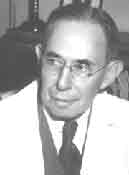Joseph Erlanger
(1874 - 1965)

Joseph Erlanger was born on January 5, 1874, in San Francisco, California. Erlanger received his B.S. from the University of California. Later he obtained his Medical degree from John Hopkins University in 1899. From 1900 to 1906, he worked as Instructor, Associate, and Associate Professor in the Department of Physiology at the Medical School at John Hopkins.
In 1906, Erlanger moved to the University of Wisconsin, Madison, where he was appointed the first Professor of Physiology at the Medical School. At Wisconsin, Erlanger began research collaboration with one of his students, Herbert Gasser. In 1910, he became the Professor of Physiology at the Washington University, St. Louis. Gasser, joined Erlanger in St. Louis, where they began studying the effects of electronics applied to physiological investigations.
Erlanger’s main research involved electrophysiology and the physiology of the circulatory system. By 1922, Erlanger and Gasser were able to analyze the electrical reactions of nerve fibers by amplifying the nerves with a cathode-ray oscilloscope. In 1932, the two men illustrated that different fibers conduct different sizes of wavelengths or impulses. Fibers of a nerve transmit impulses at various rates, conditional on the fiber’s thickness.
He was awarded the Nobel Prize in Medicine in 1944, along with Herbert Gasser, for their discovery of different types of nerve fibers. They demonstrated that fibers can have different functions, even within the same nerve cord.
Erlanger died in St. Louis, Missouri on December 5, 1965.
Sources: Nobel Prize Biography; NASA Neurolab. Photo courtesy of the American Physiological Society.


